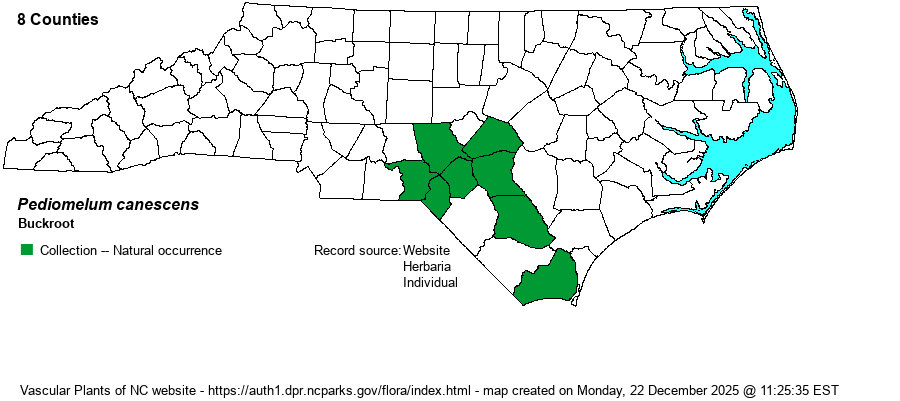| Author | (Michaux) Rydberg | |
| Distribution | Essentially just the Sandhills region of the southwestern Coastal Plain; however, scattered records farther to the southeast (Bladen and Brunswick counties).
This is a Coastal Plain species, ranging from southeastern NC (and formerly at one site in southeastern VA), south to central FL and west to AL. | |
| Abundance | Uncommon to infrequent in the Sandhills, mainly in well-maintained preserves that are frequently burned. Very rare to locally rare farther southeast to Brunswick County. The NCNHP considers this as a Watch List species. | |
| Habitat | This is a species of dry and sandy soil, usually in Longleaf Pine (Pinus palustris) sandhills, with or without a scrub oak understory. It can occur in more mesic (loamy) sites, such as into Mesic Pine Flatwoods and bean dips, but is not usually found in the driest and barest sands. As with nearly all herbs of the Longleaf Pine zone, it strongly benefits from prescribed burns. |
| Phenology | Blooms from May to July, and fruits from July to October. In fall, typically after a frost, the entire plant turns a pale brown, yet remains in place into the winter, and eventually breaks off at ground level to become a "tumbleweed". | |
| Identification | This is a quite unusual plant, deservedly pulled from the genus (Psoralea) it was placed in during much of the 20th Century. It is a very bushy herbaceous species, looking like a shrub, growing to about 3 feet tall and wide. The whole plant is somewhat pubescent. The numerous branches contain a scattering of leaves, each 3-parted; a leaflet is obovate with a rounded tip, each about 1.5 inches long and about 1/2-inch wide. Scattered over much of the outer parts of the plant are numerous but small racemes, each with 4-8 flowers. These flowers are a violet-blue to blue color and about 1/2-inch long; however, this blue color is somewhat hidden by the long standard, which is straw-colored on the back. Experienced biologists do not need flowers to identify the species, as its rounded and bushy look should suffice. One would think that the rich blue flowers would help to spot the plants, but at times you must look very closely to see the color. Also, this species never grows in clumps or patches, but nearly always singly. Thus, in a given morning walk, you may do well to see more than ten scattered plants over a large area. | |
| Taxonomic Comments | Formerly included in the genus Psoralea, as Psoralea canescens.
| |
| Other Common Name(s) | Hairy Scurfpea | |
| State Rank | S3 | |
| Global Rank | G4 | |
| State Status | W1 | |
| US Status | | |
| USACE-agcp | | |
| USACE-emp | | |

